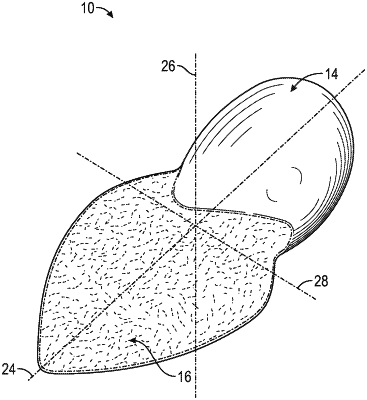| CPC A45D 34/04 (2013.01) [A45D 40/26 (2013.01); A45D 2200/1018 (2013.01)] | 14 Claims |

|
8. A cosmetics applicator,
wherein the applicator has an internal body having a shape comprising a rounded end section and an opposing tapered end section, wherein the rounded end section is integrally formed with the tapered end section, wherein the tapered end section has a pointed end,
wherein the body is formed from a material that is porous and resiliently deformable,
wherein the rounded end section and the tapered end section are covered with a flexible and non-porous exterior coating that conforms to the shape of the body and is integrally formed with the material forming the body,
wherein the body is entirely disposed internally to the exterior coating, wherein the exterior coating forms a non-porous boundary between the material forming the body and an exterior surface of the exterior coating,
wherein the applicator has a longitudinal axis, a height axis, and a width axis, wherein the rounded end section and the tapered end section are longitudinally aligned along the longitudinal axis, wherein the height axis and the width axis are each perpendicular to each other and perpendicular to the longitudinal axis, wherein the rounded end section has a maximum height that is greater than a maximum height of the tapered end section, and the rounded end section has a maximum width that is less than a maximum width of the tapered end section, and
wherein the rounded end section has an exterior curved surface on a rear end opposite the tapered end section, wherein the rear end is defined entirely by an uninterrupted curvature of the exterior curved surface, wherein the exterior curved surface extends continuously between opposing sides of the rounded end section relative to the width axis, and wherein the exterior curved surface extends continuously between a top and opposing bottom of the rounded end section relative to the height axis.
|